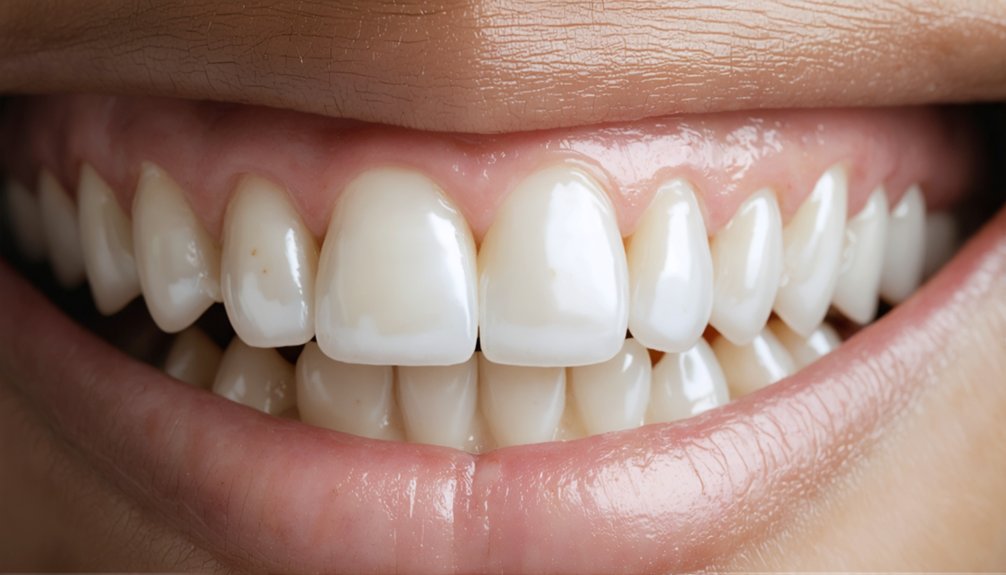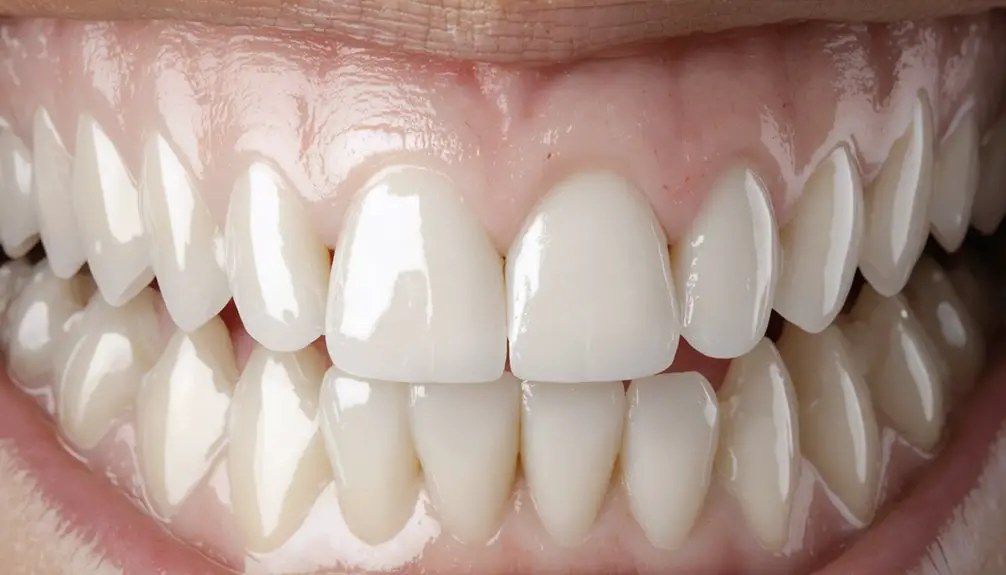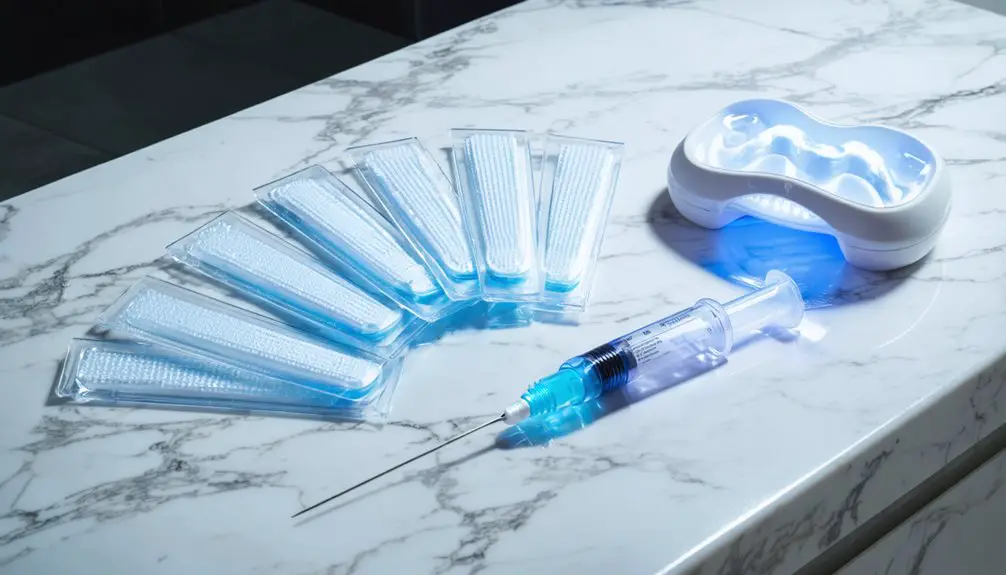You’ll need to wait 6 months after braces removal before whitening to allow proper enamel recovery. Schedule a professional cleaning first, then choose between in-office or at-home treatments based on your sensitivity levels. Use desensitizing products, maintain strict oral hygiene, and document your progress with photos. Follow application instructions carefully, avoid staining foods, and consider a combined approach of professional and at-home methods. A thorough whitening strategy will guarantee ideal, lasting results.
Key Takeaways
- Wait at least six months after braces removal before whitening to allow proper enamel recovery and remineralization.
- Schedule a professional dental cleaning to remove orthodontic adhesive remnants and get a fluoride treatment before starting whitening.
- Use custom-fitted trays and follow precise gel application guidelines, applying only 1/4 to 1/5 cc per tooth.
- Start with desensitizing products before treatment and limit whitening sessions to 20-30 minutes daily.
- Document progress with photos and shade measurements, paying special attention to areas where brackets were previously attached.
Wait for the Right Time After Braces Removal
While you may be enthusiastic to brighten your smile after braces removal, waiting for the right time is essential for ideal whitening results.
Most dental professionals recommend waiting at least six months to allow proper enamel recovery and reduce sensitivity following orthodontic adjustments.
During this healing period, your teeth naturally begin to even out in color as saliva helps minimize discoloration from bracket placement.
Your natural saliva works continuously to balance tooth color variations caused by bracket marks during the post-braces healing phase.
Your enamel needs time to remineralize and strengthen after being covered by brackets, and premature whitening could lead to uneven results or increased sensitivity.
Professional whitening treatments provide better long-term results compared to over-the-counter options.
You’ll achieve better outcomes by allowing your teeth to stabilize in their new positions before pursuing any whitening treatment.
ICON whitening is a recommended method that can effectively restore your smile’s brilliance under professional supervision.
Consulting with your dentist will help determine the best timing based on your specific dental condition and recovery progress.
Schedule a Professional Cleaning First
Once you’ve allowed adequate healing time after braces removal, scheduling a professional dental cleaning marks your next important step toward teeth whitening.
The cleaning benefits extend beyond basic hygiene, as your dental team will meticulously remove plaque and tartar that could interfere with even whitening results.
Your hygienist will use specialized tools to eliminate orthodontic adhesive remnants and thoroughly polish your teeth surfaces, creating an ideal foundation for whitening treatment. Orthodontists do not perform teeth cleaning procedures, so consulting a general dentist is essential.
They’ll also assess your enamel health, addressing any decalcification spots or vulnerabilities that developed during your orthodontic treatment.
A wait time of 1-2 weeks is typically needed after your cleaning before beginning any whitening procedures if your teeth and gums are healthy.
A fluoride treatment during cleaning will strengthen your enamel, reducing sensitivity risks during the whitening process.
This professional preparation guarantees you’ll achieve uniform brightness while protecting your oral health throughout the whitening journey.
Choose Between Professional and At-Home Whitening
After braces removal, you’ll need to decide between professional treatments and at-home whitening options, each offering distinct advantages and limitations.
Professional whitening delivers faster, more uniform results due to higher-concentration bleaching agents and expert application, while at-home kits require longer treatment times for moderate improvement.
Consider these key factors when making your choice:
- Professional treatments achieve significant whitening in fewer sessions, often just one appointment
- Dentists provide safety monitoring and can address sensitivity immediately
- At-home kits cost less initially but require extended use for comparable results
- Professional application guarantees even coverage, especially important for post-braces discoloration
- Clinical supervision prevents overuse and protects your enamel health
Waiting at least six months after removal allows teeth to stabilize and reduces sensitivity before starting any whitening treatment.
Your dentist can help determine the most suitable option based on your discoloration severity, sensitivity levels, and oral health condition. A thorough dental exam and cleaning before any whitening treatment ensures the best possible outcome.
Address White Spots and Uneven Coloration
Have you noticed white spots or uneven coloration on your teeth after braces removal?
These spots aren’t simple surface stains but rather areas of demineralized enamel caused by plaque buildup around your former brackets. Inadequate brushing during orthodontic treatment often leads to these troublesome spots. Professional whitening delivers the most effective results for post-braces staining. Traditional whitening alone won’t fix these spots and may temporarily make them more noticeable.
White spots after braces signal demineralized enamel from plaque accumulation. Conventional whitening treatments can’t resolve them and may worsen their appearance.
For effective white spot treatment, you’ll need professional intervention.
Resin infiltration can penetrate and fill porous enamel, while microabrasion gently buffs the surface before applying remineralizing agents.
For moderate cases, cosmetic bonding offers a minimally invasive solution lasting 7-10 years. Severe cases might require porcelain veneers.
Whatever treatment you choose, early intervention yields better results.
Partner with your dentist to develop a personalized enamel treatment plan that addresses both white spots and overall tooth color uniformity.
Protect Your Sensitive Teeth During Treatment
To safeguard your sensitive teeth during post-braces whitening, you’ll need to incorporate desensitizing toothpaste and mouthwash into your daily routine at least two weeks before beginning treatment.
You can minimize discomfort by scheduling whitening sessions during times when you won’t need to consume hot or cold foods and beverages for several hours afterward. Active hydrogen peroxide can penetrate tooth enamel and temporarily increase sensitivity during whitening treatments.
If you experience heightened sensitivity, consider using specialized whitening products with lower peroxide concentrations and built-in sensitivity protection, such as potassium nitrate or fluoride formulations. Professional dental consultation is recommended before starting any whitening treatment to ensure your teeth and gums are healthy enough for the process.
Use Desensitizing Products Daily
Managing tooth sensitivity during whitening requires daily use of specialized desensitizing products containing key ingredients like potassium nitrate and calcium phosphate.
For effective sensitivity management, incorporate professional-grade desensitizing gels into your daily routine before and after whitening treatments.
Here’s what you’ll need for ideal daily desensitizing:
- UltraEZ or similar potassium nitrate-based desensitizing gel
- Fluoride-enhanced remineralizing toothpaste
- Calcium phosphate paste for enamel protection
- Custom-fitted application trays for targeted treatment
- Soft-bristled toothbrush for gentle cleaning
Apply desensitizing products consistently while avoiding acidic foods and beverages.
Use straws when consuming colored drinks to minimize enamel contact.
These practices, combined with proper brushing technique, will help maintain comfort throughout your whitening journey and protect your newly straightened smile.
Time Treatments Strategically
Since teeth remain vulnerable after braces removal, strategic timing of whitening treatments plays a crucial role in protecting your dental health.
Wait approximately six months post-braces before starting any whitening techniques to allow proper enamel remineralization and strength recovery.
When you’re ready to begin treatment, schedule sessions during periods when you can manage potential sensitivity, such as weekends or days off.
Space out your whitening appointments to prevent overlapping discomfort, and avoid extreme temperature foods during sensitive periods.
For ideal sensitivity management, consider timing treatments before bedtime to leverage your natural saliva protection overnight.
Consult your dentist to create a personalized timeline that accounts for your enamel recovery and sensitivity history.
They’ll help monitor your progress and adjust treatment intervals accordingly.
Avoid Temperature Extremes
After whitening treatment leaves your teeth temporarily vulnerable, protecting them from temperature extremes becomes essential for managing sensitivity and ensuring ideal results.
Proper temperature management helps prevent discomfort as your teeth heal from the whitening process, especially during the first 72 hours when sensitivity is highest.
To minimize sensitivity triggers and protect your newly whitened teeth:
- Stick to lukewarm beverages and foods, avoiding very hot or cold items
- Skip iced drinks, including sodas and cold tea, for at least three days
- Hold off on hot coffee, tea, and soups until sensitivity subsides
- Choose room temperature water to stay hydrated without irritation
- Gradually reintroduce temperature-varied foods as sensitivity decreases
If you experience persistent sensitivity beyond one week, consult your dental professional for personalized guidance and treatment options.
Follow Application Instructions Carefully
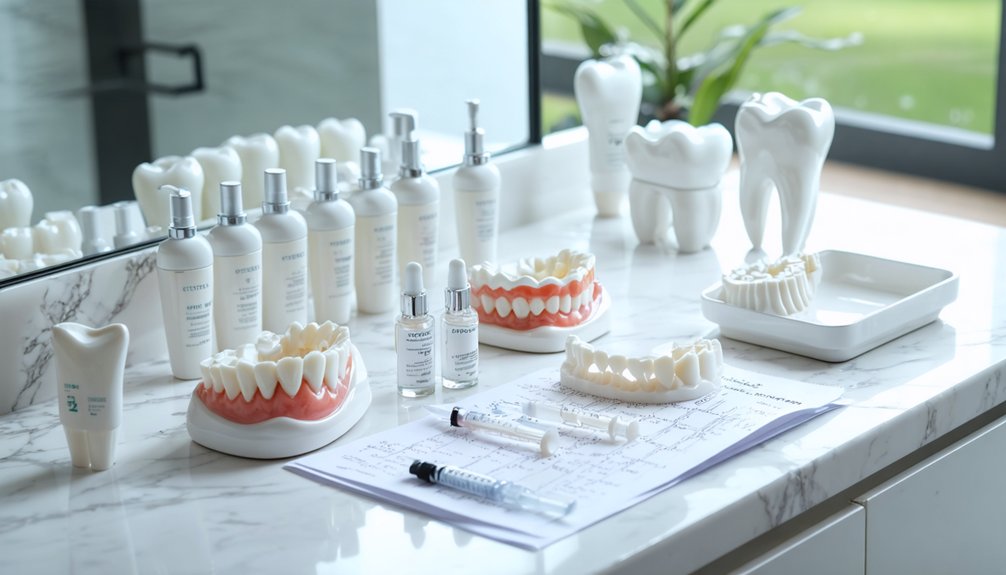
Whether you’re using professional treatments or at-home kits, following application instructions precisely is essential for safe and effective teeth whitening post-braces.
Proper gel application requires using only 1/4 to 1/5 cc per tooth, and you’ll need to remove any excess that contacts your gums immediately to prevent irritation.
Apply precisely 1/4 to 1/5 cc of gel per tooth, wiping away any excess from gums to avoid irritation and discomfort.
For ideal enamel protection, limit your daily whitening sessions to 20-30 minutes initially, never exceeding one hour.
You’ll want to clean your trays with cool water after each use and store them properly. Most treatments run for seven consecutive days, but always follow your dentist’s specific guidelines.
Remember that your teeth may be more vulnerable after braces, so strict adherence to instructions helps prevent sensitivity, uneven results, and potential damage to your newly straightened smile.
Maintain Proper Oral Hygiene Throughout
Proper oral hygiene serves as the foundation for successful teeth whitening after braces removal. You’ll need to maintain consistent brushing and flossing techniques while implementing strategic dietary adjustments to protect your newly exposed enamel.
- Brush at least twice daily using gentle circular motions with a soft-bristled toothbrush.
- Floss thoroughly with specialized tools like water flossers or interdental brushes.
- Rinse immediately after consuming staining foods or acidic beverages.
- Schedule regular professional cleanings to remove stubborn stains.
- Use fluoride products to strengthen and remineralize enamel.
Remember to brush all tooth surfaces meticulously, paying special attention to areas where brackets were previously attached.
Your diligence in maintaining proper oral hygiene will greatly impact the effectiveness of any whitening treatments while protecting your dental health long-term.
Consider a Combined Treatment Approach
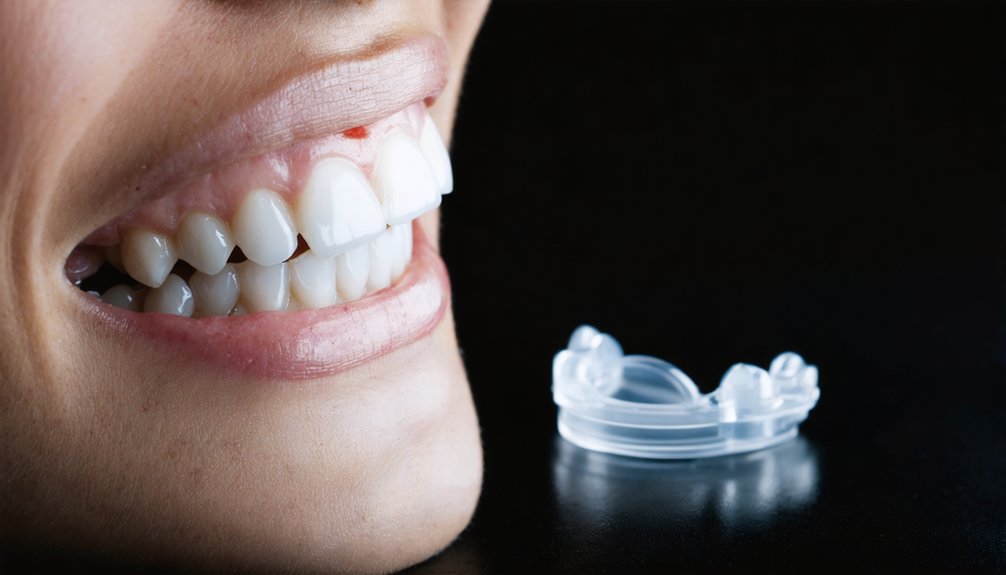
To maximize your post-braces whitening results, you’ll benefit from implementing a strategic combination of treatments that address both discoloration and potential white spot lesions.
Consider combined whitening options that merge professional in-office treatments with at-home maintenance kits for best results. You’ll achieve faster whitening through supervised in-office procedures while maintaining results with custom-fitted trays at home.
Prioritize enamel protection strategies throughout your treatment journey. Start with fluoride therapy or resin infiltration to address any white spots, then proceed with whitening once your enamel has properly recovered post-braces.
If you’re using clear aligners, you might’ve the flexibility to begin whitening during treatment, but always consult your dental professional to determine the safest timing and approach for your specific situation.
Monitor Your Progress and Results
You’ll want to track your teeth’s weekly color changes using a combination of photos and shade measurements to document your whitening progress after braces removal.
Keep a daily log of any sensitivity or gum irritation you experience during treatment, which helps your dentist optimize the whitening protocol for your specific needs.
Taking clear before-and-after photos with consistent lighting will provide concrete evidence of your results and help determine when touch-up treatments might be necessary.
Track Weekly Color Changes
Monitoring color changes throughout your teeth whitening journey is essential for achieving ideal results after braces removal. For precise color assessment, you’ll need to track progress using both visual and digital methods. Modern shade tracking tools offer reliable ways to document your teeth’s transformation.
Key methods for monitoring your whitening progress:
- Use fiberoptic measurement devices for accurate shade readings
- Compare weekly against standard shade tabs for consistent tracking
- Take standardized photos under consistent lighting conditions
- Utilize whitening apps with AI-enhanced analytics
- Document changes by comparing treated upper teeth to untreated lower teeth
Your whitening timeline typically shows initial results within days, with significant improvements appearing after 1-2 weeks of consistent use.
Regular monitoring helps adjust treatment intensity and duration while preventing overuse and sensitivity.
Document Side Effects Daily
Maintaining three essential records during your post-braces whitening treatment guarantees ideal results and minimizes potential complications.
First, track your sensitivity levels daily, noting any discomfort or pain you experience during and after treatment. Record the intensity, duration, and location of sensitivity to adjust your whitening routine accordingly.
Second, document any signs of gum irritation, including redness, swelling, or tenderness. If you notice persistent irritation, you’ll need to modify your application technique or consider using protective barriers.
Finally, maintain detailed notes about your whitening product usage, including application times and duration. This helps you identify patterns between side effects and treatment intensity, allowing you to optimize your whitening schedule while protecting your newly straightened smile’s health.
Compare Before-After Photos
A systematic approach to photo documentation provides concrete evidence of your whitening progress after braces removal. Maintain strict photo consistency by capturing high-resolution images in identical lighting conditions and camera angles before each treatment session. Include a dental shade guide in your photos for objective shade comparison over time.
Essential steps for accurate progress tracking:
- Use the same camera settings and background for all documentation
- Position yourself at consistent angles and distances
- Photograph immediately before and after each whitening session
- Avoid filters or editing that could alter true results
- Store images chronologically with dates for proper assessment
Monitor changes in tooth translucency and evaluate areas where brackets were previously attached. This documentation helps identify uneven whitening patterns and guides necessary adjustments to your treatment protocol.
Prevent Future Staining and Discoloration
Once your braces come off, protecting your newly straightened teeth from stains becomes essential for maintaining that perfect smile. For effective staining prevention, limit your consumption of chromogen-rich beverages like coffee, tea, and red wine.
When you do indulge, use a straw to minimize contact with your front teeth, and rinse immediately afterward.
Make smart dietary adjustments by reducing intake of pigmented foods such as berries and tomato sauce.
Maintain rigorous oral hygiene by brushing twice daily with fluoride toothpaste and flossing regularly.
Consider using an electric toothbrush for superior plaque removal, especially in areas where brackets were previously attached.
Schedule professional cleanings regularly, and wait 2-4 weeks post-braces before starting any whitening treatments to allow your enamel to recover fully.
Frequently Asked Questions
How Long Do Teeth Whitening Results Typically Last After Braces?
Like a fresh canvas, your brightened smile can last 6-24 months with proper teeth maintenance. You’ll need occasional whitening frequency touch-ups, and results vary based on your diet and oral care habits.
Can I Whiten My Teeth if I Still Have a Permanent Retainer?
You can safely whiten your teeth with a permanent retainer, but you’ll need professional guidance to address whitening safety concerns and maintain even results around the bonded wire areas.
Will Whitening Affect the Dental Cement Used During Braces Treatment?
Yes, whitening can affect dental cement, raising safety concerns by potentially weakening bond strength. However, if you wait until after braces removal and complete cement cleanup, you’ll avoid risks to cement integrity.
Are There Specific Whitening Products Designed for Teenagers After Braces?
You’ll find specially formulated teen whitening kits with gentle peroxide levels and natural ingredients. Safe whitening options include dentist-supervised treatments and OTC products designed specifically for post-braces teenage teeth.
Should I Whiten My Teeth Before Getting Photos Taken With My Braces Off?
You’ll achieve better photo results by whitening after braces removal since brackets block whitening agents. Wait a few days post-removal to let gums settle before starting your photo preparation and whitening treatment.
References
- https://www.kingstownedentist.com/post/whitening-your-teeth-after-braces-everything-you-need-to-know
- https://summerhillorthodontist.com/teeth-whitening-after-braces-best-practices/
- https://www.salmoncreekdentistry.com/blog/professional-teeth-whitening-after-braces-achieving-a-brighter-smile/
- https://www.theorthodontists.com.au/blog/teeth-whitening-after-braces-should-i-get-my-teeth-whitened
- https://www.smileteam.com.au/blog/teeth-whitening-after-braces/
- https://lasterortho.com/teeth-whitening-after-braces/
- https://orthodonticsaustralia.org.au/teeth-whitening-braces/
- https://www.belmarorthodontics.com/teeth-whitening-after-braces/
- https://babanmahaldds.com/blog/getting-professional-teeth-whitening-after-braces/
- https://www.dentalinnovations.com/post/teeth-whitening-after-braces-in-mesa
